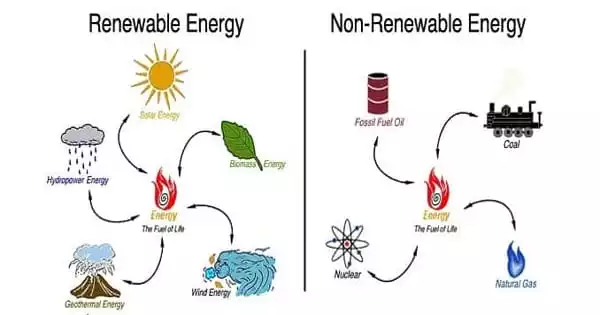Resources are classified as renewable or nonrenewable; a renewable resource can replenish itself at the rate at which it is depleted, whereas a nonrenewable resource has a finite supply. Nonrenewable resources include coal and natural gas, while renewable resources include timber, wind, and solar. When compared to non-renewable resources, renewable resources emit less carbon. As a result, they are pollution-free and environmentally friendly.
Nature has blessed living organisms with its gifts, as it has made our planet the best place to live. Life would be unthinkable without the resources provided by nature, such as plants, food, sunlight, air, water, fuels, and so on. These resources are important in making our lives easier and better because we use them as a source of energy in our daily lives, such as gasoline in our motorcycles, electricity in our homes or offices, food and water to survive, and so on.
Difference between Renewable and Non-renewable Resources –

RENEWABLE RESOURCES
- Renewable resources are those that replenish themselves naturally and in a short period of time. Renewable resources are those that can be replenished through natural processes over time.
- Renewable resources, as the name implies, are natural assets that can be replenished in the future. Because the resources can be naturally revived, they can be used repeatedly. Renewable resources include biomass, oxygen, water, and sunlight, to name a few.
- These resources are replaced at a rate that is faster than or equal to the rate of usage, in the sense that the resources regenerate themselves over time. This type of resource is enduring in nature and never goes extinct, i.e. it is thought to have constant supplies over time and includes solar energy, wind energy, hydroelectricity, and so on.
- Renewable resources do not go extinct easily, so they are naturally sustainable. These can be found in an infinite number in nature.
- Renewable resources regenerate/reproduce themselves faster than they are depleted by living organisms.
NON-RENEWABLE RESOURCES
- Non-renewable resources are those that cannot be replaced in the near future. Non-renewable resources are natural resources that will not be replenished in the near future.
- Non-renewable resources are those that do not regenerate on a large enough scale to allow for long-term economic extraction in the specified time frame. These natural resources are limited in quantity and cannot be replenished once depleted. Coal, fossil fuel, crude oil, nuclear energy, and other nonrenewable resources are examples.
- We are heavily reliant on nonrenewable resources because they are our primary source of energy. These are found deep within the earth and regenerate over time.
- Non-renewable resources deplete over time, implying that they are exhaustible in nature and can be depleted when subjected to large-scale consumption. There is a limited supply of these.
- Non-renewable resources either take centuries to regenerate or become extinct, so the scale at which they are regenerated is smaller than the scale at which they are consumed.
Because renewable resources are abundant, they are less expensive than nonrenewable resources, which are more expensive. Renewable resources, on the other hand, have a higher maintenance cost than non-renewable resources.
















